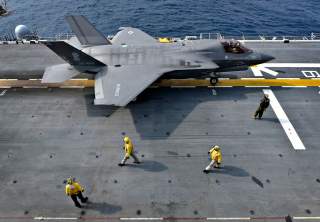Scandal? the Pentagon’s Director of Operational Test and Evaluation Claims His Colleagues Are Lying About the F-35's Problems
What happens now?
Furthermore Gilmore said that 276 F-35’s deficiencies remain unresolved.
Dr. J. Michael Gilmore, the Pentagon’s Director of Operational Test and Evaluation, said in an internal memo (obtained by Bloomberg.com) to Frank Kendall, the Under Secretary of Defense for Acquisition, Technology and Logistics, that a draft response to Senate Armed Services Committee Chairman John McCain, who raised questions about the current status of the F-35 program, had contained misleading information.
John McCain, the U.S. Senator for Arizona, in a Nov. 3 letter to departing Defense Secretary Ash Carter expressed his doubts about the F-35 Lightning II fighter jet. Specifically McCain said he is very concerned about the aircraft continuous delays and cost overruns.
According to Bloomberg.com, in his Nov. 28 memo Gilmore says that the draft responses given to McCain “ignore acknowledged facts, are ambiguous and misleading and if signed and sent as-is” could “generate substantial issues with the Congress,” and that they should “be revised to provide clear, accurate and complete answers.”
In his memo Gilmore too raises doubts about F-35’s performance in key tests: a point of view that disagrees with Pentagon’s claims that the Joint Strike Fighter (JSF) program is on course after earlier problems.
Gilmore doubts mainly focus on F-35’s development phase: in fact the memo says that will not be completed until mid-2018 (and not in early 2018 as claimed by the Defense Department). Moreover Gilmore labeled as “false” the assertion which states that “Operational combat testing that all weapons systems must pass will start in mid-2018 and be completed a year later.” Indeed, the memo reports that the tests are due to begin “no sooner than late 2018, or, more likely, in early 2019 but could be as late as 2020.”
Furthermore Gilmore said that 276 F-35’s deficiencies remain unresolved.
The F-35 major shortcomings highlighted in the memo include:
-
Critical delays faced by the final version of the F-35 software.
-
New delays in live-fire testing of the aircraft’s gun.
-
Inadequate wing strength of the F-35C (the U.S. Navy carrier variant of the aircraft) when carrying the AIM-9X Sidewinder short range air-to-air missile.
-
Excessive F-35C vertical oscillations (or shaking), experienced by the aircraft during catapult shots from aircraft carriers.
-
Symbols on the Rockwell Collins F-35 Generation III Helmet Mounted Display System (HMDS) “unusable and unsafe” to perform air-to-ground missions.
Spokesman for the Pentagon’s F-35 program office, Joe DellaVedova, replied to Gilmore’s memo saying that additional improvements were incorporated in a software update released in November and that flight-testings of the latest software version are due to be completed by late 2017, with the first aircraft ready to be deployed from late 2017 to spring 2018.
Instead director of the Navy’s F-35C integration office, Rear Admiral Roy Kelley, replied to Gilmore’s memo with an email claiming that his service is confident that the program will address discrepancies found and aggressively pursue the fixes. According to Kelley in fact, the U.S. Navy “has identified a few F-35C specific discrepancies, to include the load limitations for carriage of AIM-9X, as well as the vertical oscillations during catapult launch.”
The troubled F-35 Lightning II, which is the result of the JSF program, has been originally designed to replace aging fighter inventories including U.S. Air Force F-16s and A-10s, U.S. Navy F/A-18s, U.S. Marine Corps AV-8B Harriers and F/A-18s, and U.K. Tornados, Harrier GR.7s and Sea Harriers. Three Joint Strike Fighter variants have been developed to fulfill this difficult task: the F-35A conventional takeoff and landing (CTOL) variant, the F-35B short take-off and vertical-landing (STOVL) variant, and the F-35C carrier-based Catapult Assisted Take-Off But Arrested Recovery (CATOBAR) variant.
Now, as explained by Bloomberg.com, Gilmore’s memo could affect president-elect Donald Trump decision to increase F-35 production to 70 in fiscal 2018 from 63 this year, as requested by the Defense Department.
Trump has already expressed his lack of confidence in the program in Oct. 2015 when he said during a radio interview that “existing planes are better.”
This article by Dario Leone originally appeared on The Aviation Geek Club in 2016.
Image: Wikimedia.

